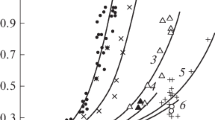Abstract
A mathematical model simulating a cell growing in a culture medium is obtained. Using this model, various behavioral patterns of the cell are obtained under different types of disturbances, in particular when (i) a Mg2+ deficiency experiment and, (ii) a split-dose ionizing radiation experiment are carried out, (iii) when disturbances on the rate constants of the biochemical reactions taking place in the nucleus of the cell are applied, and (iv) when the cell's interior components are perturbed. The cell model results obtained agree well with experimental results for the Mg2+ and split dose experiments, and explain the mechanism of the split dose radiation experiment without the need to introduce additional axioms (e.g. healing processes) into the dynamics of the cell. Conditions are obtained which cause the cell to behave in a rapidly growing ‘tumor-like’ mode; it is shown that once the cell moves into this ‘tumor-like’ mode, its behavior is irreversible, i.e. if a disturbance of opposite type is then applied to the ‘tumor’ cell, the cell will not revert back to its original normal behavior.
Similar content being viewed by others
Literature
Davison, E. J. 1973. “An Algorithm for the Computer Simulation of Very Large Dynamic Systems.”Automatica,9, 665–675.
Diamant, N. E., P. K. Rose and E. J. Davison. 1970. “Computer Simulation of Intestinal Slow-Wave Frequency Gradient.”Am. J. Physiol,219, 1681–1690.
Elkind, M. M., T. Alescic, R. W. Swain, W. B. Moses and H. Sutton. 1964. “Recovery of Hypoxic Mammalian Cells from Sub-Lethal X-Ray Damage.”Nature, Lond.,202, 1190–1193.
Glueck, A. R. 1969. “Simulation of Cell Behavior.” Private communication.
Heinmets, F. 1964a. “Analog Computer Analysis of a Model-System for the Induced Enzyme Synthesis.”J. Theoret. Biol.,6, 60–75.
— 1964b. “Elucidation of Induction and Repression Mechanisms in Enzyme Synthesis by Analysis of Model System with the Analog Computer.” InElectronic Aspects of Biochemistry, pp. 413–479. New York: Academic Press.
— 1966.Analysis of Normal and Abnormal Cell Growth New York: Plenum Press.
Himmelblau, D. M. and K. B. Bischoff. 1968.Process Analysis and Simultation New York: Wiley.
Jansson, B. 1968. “Mathematical Description of the Growth of Tumor Cell Populations with Different Ploidi-Compositions,”6th Annual Symposium in Math and Computer Science in the Life Sciences, Houston.
Little, J. B. 1968. “Cellular Effects of Ionizing Radiation.”New England J. Medicine,278, 369–376.
Mallette, M. F., C. P. Clagett, A. T. Phillips and R. L. McCarl. 1971.Introductory Biochemistry. Baltimore: Williams & Williams.
McCarthy, B. J. 1962. “The Effect of Magnesium Starvation in the Ribosome Content ofEscherichia Coli.”Biochim. Biophys Acta,55, 880–888.
Medoff, G. and M. N. Swartz. 1967. “DNA—Structure and Enzymatic Synthesis.”New England J. Medicine,277, 728–737;276, 788–795.
Mesarovic, M. D. (ed.). 1968.Systems Theory and Biology. New York: Springer.
Mitchison, J. M. 1965.The Biology of the Cell Cycle. Cambridge University Press.
Palmby, F. V., E. J. Davison and J. Duffin. 1964. “The Simulation of Multi-Neurone Networks: Modelling of the Lateral Inhibition of the Eye and the Generation of Respiratory Rhythm.Bull. Math. Biology,36, 77–89.
Pollard, E. 1960 “Theoretical Aspects of the Effect of Ionizing Radiation on the Baterial Cell.”Am. Naturalist,XCIV, 71–84.
Sinclair, W. K. and B. A. Morton. 1964. “Survival and Recovery in X-irradiation Synchronised Chinese Hamster Cells.”Cellular Radiation Biology Proc., 18th Ann. Symp. Fund. Cancer Res. Univ. Houston, Texas.
Teir, H. and T. Rytömaa (eds.). 1967.Control of Cellular Growth in Adult Organisms. New York: Academic Press.
Warner, J. R. and R. Soeirs. 1967. “The Involvement of RNA in Protein Synthesis,”New England J. Medicine,276, 563–570;276, 613–619;276, 675–680.
Weinberg, R. and B. P. Zeigler. 1969. “Computer Simulation of a Living Cell: Multilevel Control Systems.”Report 08228-17-T. Ann Arbor, Michigan: University of Michigan.
Yeisley, W. G. and E. C. Pollard. 1964. “An Analog Computer Study of Differential Equations Concerned with Baterial Cell Synthesis.”J. Theoret. Biol.,7, 485–503.
Author information
Authors and Affiliations
Rights and permissions
About this article
Cite this article
Davison, E.J. Simulation of cell behavior: Normal and abnormal growth. Bltn Mathcal Biology 37, 427–458 (1975). https://doi.org/10.1007/BF02459513
Received:
Issue Date:
DOI: https://doi.org/10.1007/BF02459513




